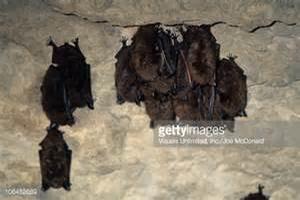Our Bats in Peril (2011)
Our native bat populations are in great peril as you probably know. Little brown bats, the worst impacted, have been the northeast's most numerous bat species. Eastern small-footed myotis and eastern pipistrelles have also been stricken, big brown bats to a lesser extent. The Indiana myotis protected by the Endangered Species Act, already in trouble may now become extinct.
White-nose syndrome (Geomyces destructans) thrives in cold humid environs attacking hibernating bats in caves ("hibernacula") where generations have resided for decades and in some cases likely hundreds of years. The fungus, believed to have come from Europe penetrates deep into the skin manifesting on the snout and ears but is most damaging to the animals' wings. The fungal disorder disorients bats who awaken early from hibernation, venture from protective cover seeking food which is unavailable and then emaciated and starving succumb to freezing temperatures. Science News reports that "45% of the little brown bat population continues to die each winter". At this rate our regional Myotis lucifugus would become non-existent in northeastern North America in 16 years. The problem has been recorded into eastern provinces of Canada, as far south as Tennessee and now found in West Virginia. The malady appears to be spreading. In some caves as many as 75% of inhabitants are dead. Some reports cite that in other hibernacula 90% to 100% of inhabitants have succumbed. In that little brown bats span North America it is hoped that they would not be wiped out in entirety everywhere but presently northeastern bats are the more numerous recipients of this tragedy that has struck suddenly, stridently and spreads quickly.
The contagion is communicable bat to bat and possibly also transmitted bat to cave to bat. It is not known if the fungus is directly responsible for deaths or if it is the catalyst for disorientation, emaciation and immune suppression that foretells untimely demise. But it is safe to say that if the bats were not infected they would not be dying in such alarming numbers.
What conditions precipitate infection? We do not know. David Blehart, a microbiologist employed by the U.S. Geological survey, has conjectured that ingested contaminants might be the culprit. He has theorized, too, that pesticide use may have reduced the numbers of insects upon which bats feast cheating bats of the food they require to fatten-up before hibernation; that, in turn, weakens immune response and increases susceptibility to the fungus. At this point I might humbly postulate that pesticide infused insects, still flying, eaten by bats may also be a contributing factor. Dr. Blehart has also postulated that bats that would normally sleep through the winter awaken frequently due to irritation caused by the infection. When repeatedly aroused infected bats usurp the necessary winter padding of fat in their bodies the result is emaciation, hunger and early emergence from hibernation.
A new theory suggests that dehydration from water loss caused by the infection in the bats' wings arouses these extraordinary mammals to precocious consciousness. In this hypothesis it is the thirst for water which causes early emergence from hibernacula. But again, no one knows with certainty. It's entirely possible that any combination of the interrelated conditions might work together in a perfect deadly storm.
You may query, "So what! Who cares about bats?" Consider this: bats eat flying insects and lots of them. A single voracious bat is masterful in consuming mosquitoes ingesting as many as 1,000 individuals of this winged menace in a single hour! An up-tick in mosquito borne illnesses is inevitable if tenacious blood sucking mosquitoes are not kept in check. Indeed, the numbers of individuals contracting mosquito-borne illnesses in the northeast is rising. More pesticide use may kill insect pests but may also inadvertently contribute to and foster even more bat deaths as well as deaths of so many beneficial bees, some necessary for pollination of fruits and vegetables. Unnecessary pesticide use in general will degrade living soil structure and can poison well water. Bats reduce populations of these marauding insect pests which fly at dusk and do so elegantly, with finely tuned sonar.
We, at Quackin' Grass had a vibrant population living in spaces under boards attached where outer walls meet the roof line of our gambrel-style barn. We're delighted to still see a few flying and flitting silhouetted against dusky skies. We are saddened to survey so few, however. It is a far cry from that memorable warm evening I ventured outdoors; to my amazement there were easily 100 or more individuals flying in a large circular rotation 10 to 20 feet above the ground. I think I happened upon a mating ritual. I expect that some descendants we see presently came from that lusty evening. May our bats survive and prosper.
penned by Wayne Paquette for The Potting Shed, Villager Newspapers, September 2011
